Museums Doge's Palace | Guggenheim | Correr | Pesaro | Rezzonico | Murano | Accademia | Oriental | Ca d'Oro | Archeological | Querini | Bovolo | Pisani | Fortuny | Rocco | Lace | Marciana | Grassi | Dogana
Ca' d'Oro History | Location | Opening Hours Tickets | Authorizations
History In Gold | On the Water | Construction | Franchetti | Lace | Beauty
The Palazzo della Ca' d'Oro in Venice in Italy
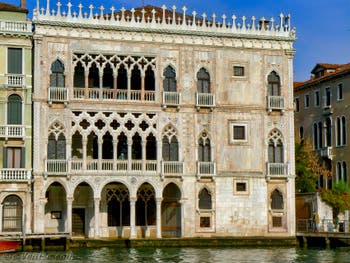
The Ca' d'Oro Palace The Ca' d'Oro is undoubtedly one of the most beautiful palaces in the flamboyant Gothic style in Venice, and we are far from being able to picture this palazzo in its original appearance, with its façade covered in gold and painted in lapis lazuli.
This combination of gold and ultramarine blue was intended to make the appearance of the Ca' d'Oro, the Golden House, even more enchanting.
The story of the construction of the Ca' d'Oro begins in 1421.
its owner and master builder, Marin Contarini, was a wealthy patrician of Venice, appropriately listed in the Golden Book, the Libro d'Oro of the nobles of the Serenissima.
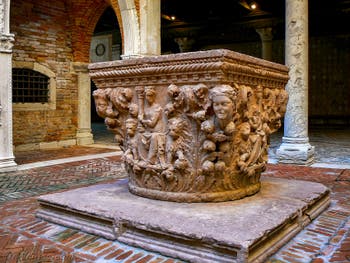
Well in the courtyard of the Ca' d'Oro And the Ca' d'Oro is very clearly the way for him to raise his prestige to the level of the biggest names in the city of Venice.
All the architectural options he decided to use for his palace are a clear example of this: the gold covering the façade, the lapis lazuli, which was one of the most expensive colour pigments of the time, the marbles, the sculptures and finally the upper crenellation of the Ca d'Oro, imitating the centre of power in Venice, the Doges himself.
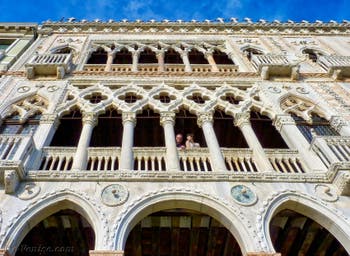
The Palace of the Ca' d'Oro. You only need to know that 23,000 sheets of gold originally covered the façade of the Ca' d'Oro to understand the luxury involved in building this Palace, which moreover, is located on the most beautiful “avenue” in Venice, the Grand Canal.
But let's get back to the construction of the palace, this “Golden House”.
So it was in 1421 that Marin Contarini began work on his dream palace. And as wealthy as he was, he started at the beginning, namely to manage as best he could the problem and also the cost of the foundations of the Ca' d'Oro.
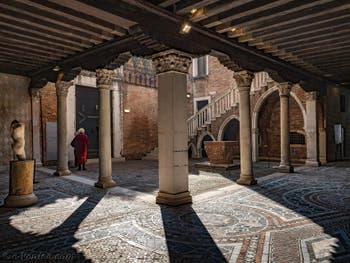
The courtyard of the Ca' d'Oro. Like all Venetian buildings, from the smallest hovel to sumptuous palaces and churches, the foundations of Venice's buildings were made using piles driven deep into the lagoon floor.
These piles, which were between 3 and 5 metres long, were driven side by side, in rows of two or three.
These rows of piles were followed by inverts, a kind of thick, solid wooden pontoons.
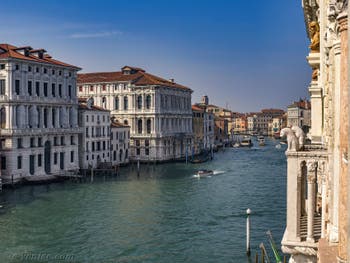
The view from the Ca' d'Oro The Venetian builders then laid large blocks of stone on these inverts. The stone used was generally white Istrian stone, which can be seen in almost all Venetian buildings.
These precisely cut blocks of stone were placed end to end to create a new horizontal row directly superimposed on the wooden rafters.
The piles, rafts and stone blocks of the upper row formed the foundations for the load-bearing walls of the future palazzo.
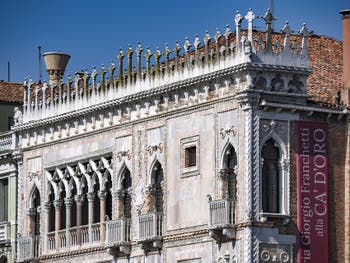
The Palazzo della Ca' d'Oro. The weight of the building was very well distributed over all the piles driven into the lagoon, which were perfectly secured to each other by the inverts that covered them, which also gave great stability to the building as a whole.
But this technique had another major advantage: it effectively insulated the walls of the palace from the aggression of the water in the lagoon.
As the palace walls, with very few exceptions, were made entirely of brick, there was a high risk of water rising through them by capillary action (the principle of blotting paper).

The mosaics in the courtyard. Now a brick is a perfect porous material to play the role of blotter!
Thanks to this construction technique, the bricks could not come into direct contact with the water in the lagoon, as they were insulated from it by the double row of wooden rafters and, above all, the row of stone blocks.
Although brick was the perfect building material for Venice due to its lightness, the effects of salt water combined with the onslaught of frost in winter were just as dangerous for the walls of palaces and churches.
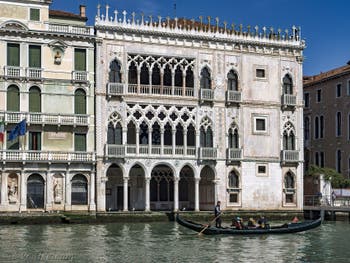
The Ca' d'Oro Palace The current phenomenon of Moto ondoso, which is now dramatically degrading the Venetian Palazzi, is here to show us the importance of this risk.
Except that the water that is now attacking the bricks and facades of Venice's Palazzos and houses is that of the repeated waves generated, hundreds of times a day, by the motorboats travelling (too fast) through Venice's canals.
A phenomenon that the builders of the Ca d'Oro in 1421! obviously hadn't foreseen.
History In Gold | On the Water | Construction | Franchetti | Lace | Beauty
Ca' d'Oro History | Location | Opening Hours Tickets | Authorizations
Museums Doge's Palace | Guggenheim | Correr | Pesaro | Rezzonico | Murano | Accademia | Oriental | Ca d'Oro | Archeological | Querini | Bovolo | Pisani | Fortuny | Rocco | Lace | Marciana | Grassi | Dogana
Back to Top of Page

